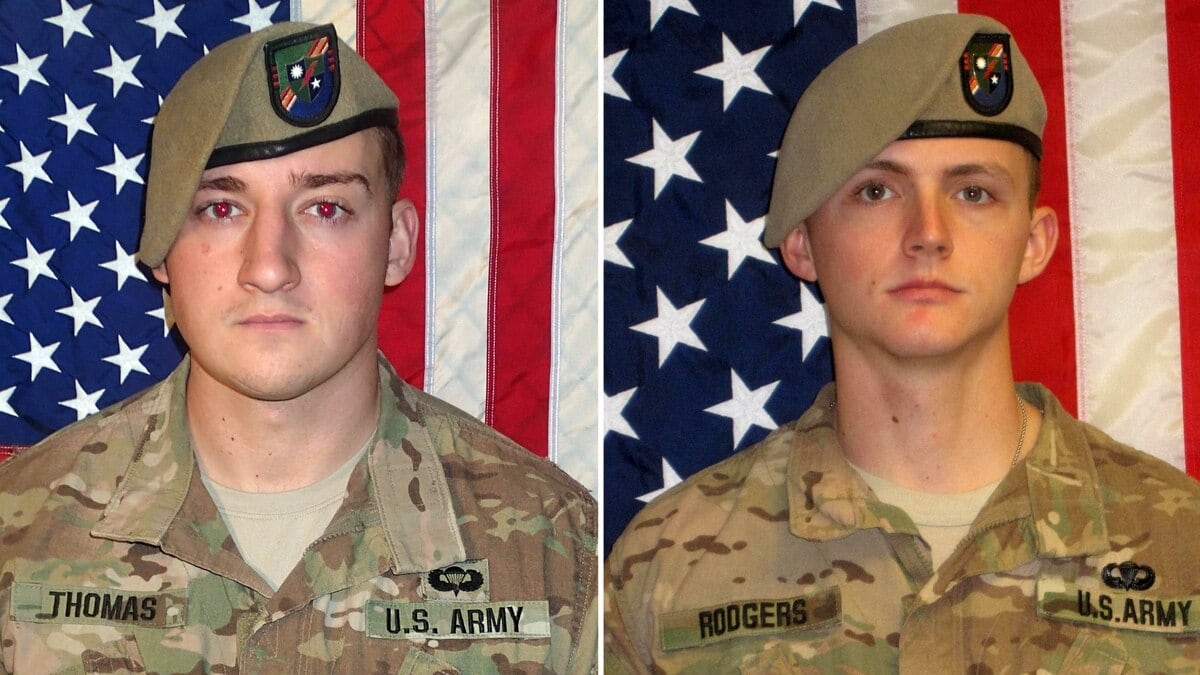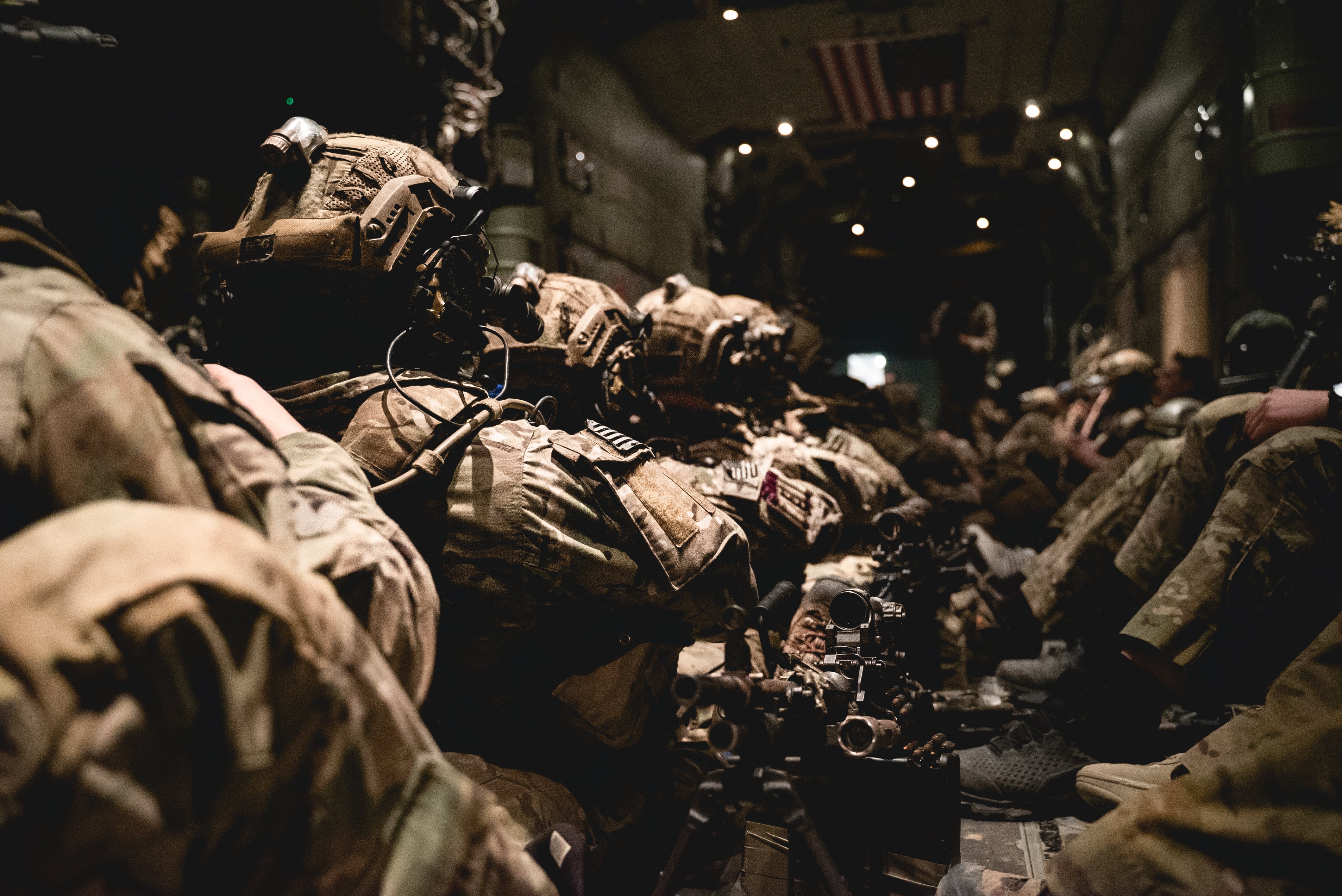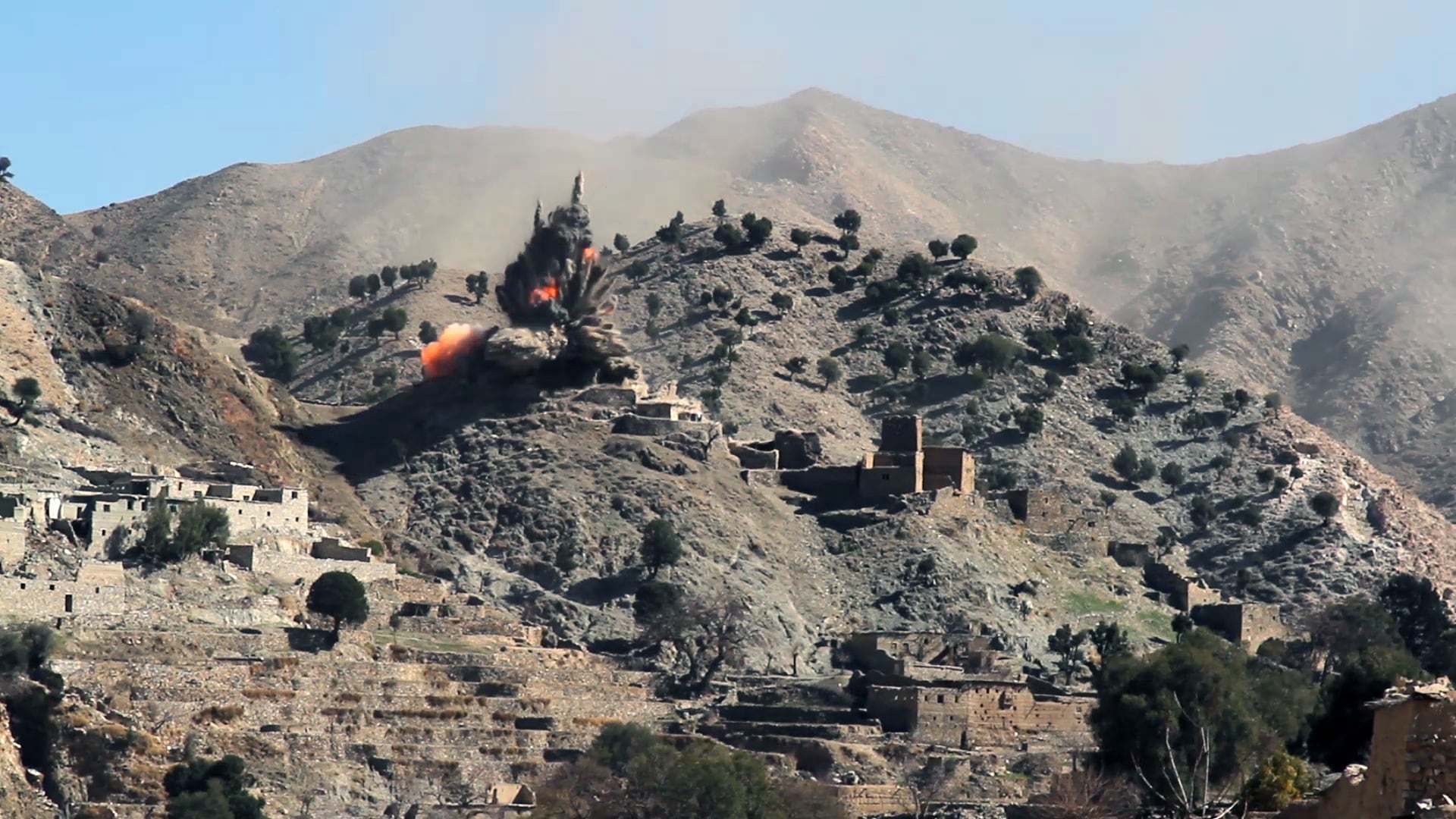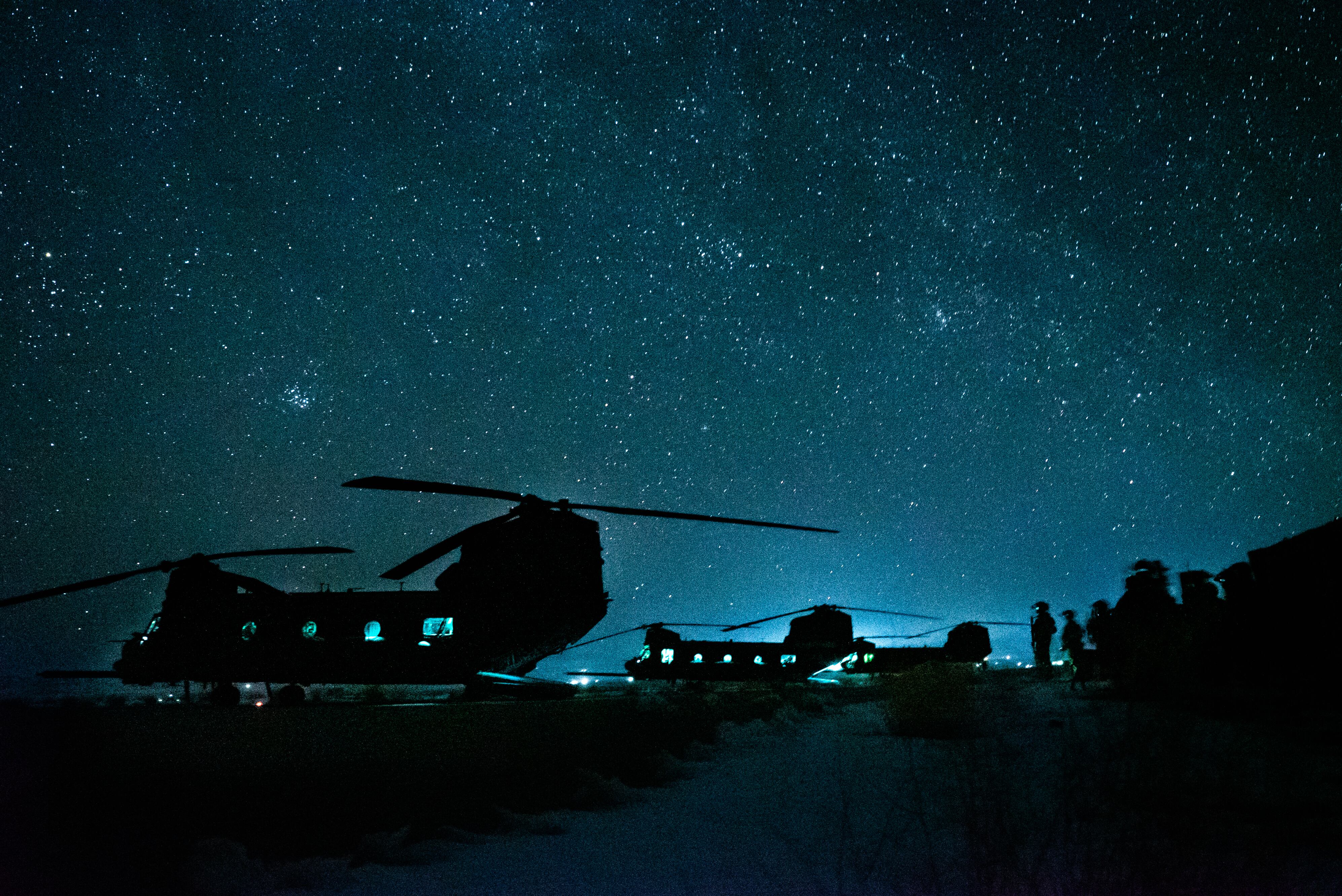Infrared lasers swept over the contingent of U.S. Army Rangers as they traversed eight-foot-high stepped terraces within eastern Afghanistan’s Mohmand Valley on the night of April 27, 2017.
From the moment those Rangers fast-roped into the valley until they departed, they were under a constant hail of gunfire from barricaded Islamic State-Khorasan positions. But the rounds accompanying those lasers, which mortally wounded two Americans, weren’t shot by ISIS militants guarding the emir for whom U.S. and Afghan forces came that night.
Instead, the fatal shots originated from an already besieged foothold occupied by other U.S. troops, dubbed Battle Position-South, according to a previously unreported investigation into the incident obtained through the Freedom of Information Act by Army Times.
“Many of us sent a laze back signaling not to shoot us,” one Ranger told investigators. “As we continued to move, I began to hear the cracks of bullets hitting all around us. I immediately hit the ground and noticed the fire seemed to be coming from the lasers.”
Steep terrain and dense foliage shrouded the infrared markings worn by the Rangers, and the sheer number of calls made over the radio network eclipsed their order to cease fire.
Battle Position-South was dealing with an onslaught of its own, as a grenade was hurled at troops there and enemy fire engulfed their position. Close by, a third group of Rangers in the primary assault force were moments away from breaching the ISIS-K emir’s compound, adding more radio calls to the already choked frequencies.
As troops crushed breaching tools into the compound’s door, a Ranger who was providing suppressive fire fell through the rooftop on which he was standing. Fellow Rangers went to assist him, fatefully delaying movement through the breach and avoiding a suicide bomber’s detonation in a courtyard on the other side.
After the blast, the team entered through the debris and engaged in several close-quarter gunfights that ultimately killed a person the investigation called “OBJ Nascent Calvia.” The raid was credited by Pentagon officials with slaying several dozen militants, including Abdul Hasib Logari, a former Taliban militant who defected and commanded ISIS’ Afghanistan branch until his death inside the compound.
Fortified and heavily armed
The three-hour gunfight didn’t start or end with Hasib’s death. The Rangers faced “immediate and incredibly intense contact for the duration of the mission,” the investigators wrote, battling through an objective area to treat and evacuate their wounded comrades under enemy fire that “completely enveloped” the raiding party.
“This intensity of enemy contact both contributed to the friendly fire incident and also illustrated the valor of U.S. forces,” the investigators wrote.
Tunnels and trenches connected the ISIS fighting positions and encircled the ISIS compound targeted by 50 soldiers from 3rd Battalion, 75th Ranger Regiment, and 40 commandos from Afghanistan’s Ktah Khas battalion. But a critical change to the mission early on proved ruinous.
The secondary assault force, which included fallen Rangers Sgt. Joshua Rodgers, 22, and Sgt. Cameron Thomas, 23, was diverted to a backup helicopter landing zone to fast-rope in, rather than land. As they descended, already under small-arms fire and with one Ranger suffering a fall from the ropes, the primary assault force was preparing to breach the objective compound.

The “loss of tempo” and “increased distance” placed the Rangers in the secondary assault force close to ISIS fighters engaging Battle Position-South, the investigation reads. As they “initiated movement north to the objective, they found themselves in the middle of crossfire between U.S. forces at BP-South and enemy forces.”
The raid occurred during a period of zero illumination, further inhibiting U.S. forces’ ability to discriminate between friendly and enemy positions amid an onslaught of rocket-propelled grenades, AK-47 rifle and PK machine gun fire. The lack of illumination also negated the effectiveness of night vision goggles in terrain already flush with vegetation obstructing their fields of view.
Mortally wounded, they fought on
Rodgers, a team leader, was wounded first. He suffered a gunshot wound, immediately “placed a tourniquet on his own leg and continued the fight” with his teammates, the investigation reads. But the volume of fire “increased tremendously,” and Rodgers suffered a second, and this time fatal, wound.
Separately, Thomas and another soldier dropped into the prone position and rolled to their right, falling 10 feet onto a lower terrace, as soon as they started receiving effective fire. Thomas notified his teammate he was hit and having trouble breathing. The teammate began removing Thomas’ equipment and swept his body for wounds.
When fellow Rangers heard of the casualties on their squad internal radio, they left their cover under fire, running across an exposed terrace and found Rodgers unresponsive in an irrigation channel. They had to cut away his weapon and aide bag to pull him from the water.

A Ranger medic broke out his redlight to examine Thomas’ wounds, but the small-arms fire became more accurate and he was forced to complete the rest of his treatment using a night vision device. The medic declared Rodgers “expectant,” meaning the probability of death is likely, and determined that Thomas was in urgent need of surgical treatment. A nine-line medical evacuation request was sent up.
The care provided to Rodgers and Thomas “was not only appropriate, but exceptional,” the investigators noted. They praised the Ranger medic for tending to his wounded teammates “under intense and aggressive fires,” scanning for wounds under extremely low light and demonstrating “a high degree of physical strength” as he single-handedly provided CPR to Thomas for 15 minutes.
Another Ranger was praised in the investigation for, after falling from his fast rope during the insertion, rallying his element and leading them through the entrenched enemy positions to evacuate their wounded under fire.
Aircrews flew low and fast
A joint terminal attack controller and two forward observers called in airstrikes to suppress enemy positions as the MedEvac helicopters were flown in.
“I counted no less than four RPGs and a heavy volley of tracer fire that engulfed the aircraft,” one aircrew member recalled in an interview with investigators. The helicopters navigated in under zero illumination “towards the wounded Rangers, closing to within a few feet of the ground at over 130 knots airspeed,” the investigation reads.
Upon touching down, the left side of the MedEvac helicopter began to receive enemy contact, causing the left gunner and left ramp to respond with suppressive fire.
The flight medic and a member of the surgical team leaped from the helicopter to help load Rodgers and Thomas amidst the attack. It took five minutes to secure the casualties.
“Despite the accuracy and effectiveness of the suppressive fire, the enemy demonstrated the capability to replenish their killed and wounded in the surrounding compounds,” the investigation reads. “The environment became so kinetic that, after setting the flight plan for departure, [the pilot] was forced to roll down his window and engage approaching enemy fighters with his organic M4.”

The helicopters continued to take gunfire as they flew out of the Mohmand Valley. The pilots flew low and increased their airspeed to reduce the volleys coming from compounds below.
“After learning that the casualties had succumbed to their wounds, the pilots slowed the aircraft and continued on, without incident, to Jalalabad Airfield,” the investigation reads.
Origin of the friendly fire
The Afghan partner force accompanying the Rangers on the raid, known as Ktah Khas, often carry M4 carbines, and would later be implicated in a friendly fire incident that felled a Ranger in November 2018, Army Times previously reported. Another alleged friendly fire incident in March 2019 highlighted the reality that enemy combatants in Afghanistan have obtained and used American weaponry through battlefield capture and black-market purchases.
Thomas and Rodgers’ element wasn’t only hit by friendly fire. And ISIS militants, using the tunnels and interconnected trenches, were able to maneuver in close proximity to U.S. positions. But citing witness statements, autopsies and ballistics evidence, the investigators ultimately determined that both Rangers most likely “died as a result of friendly fire by U.S. forces.”
Forensic evidence from Rodgers’ wounds, for instance, was consistent with those found in NATO ammunition.
“While the bullet fragments recovered were too damaged to determine the exact type of ammunition, all available evidence strongly suggests that the fatal rounds were fired from friendly forces,” the investigators concluded.
The hellish, hours-long firefight in the Mohmand Valley was one of many that plagued Nangarhar, the restive province along the Pakistan border where the valley sits.
The past three years have seen heavy U.S. engagement, and casualties, in the region, as American and Afghan forces escalated their campaign to crush the ISIS offshoot that sprung up there. Even the Taliban have fought to curb ISIS strongholds in Nangarhar.
“That’s some of the worst terrain in the world. They have paid a very steep price in their own fighters,” U.S. Central Command boss Gen. Frank McKenzie told lawmakers in March. “It was a bloody mess … but ISIS, really now no longer holds ground in Nangarhar province.”
The ISIS affiliate has lost more than half of its estimated 2,000-5,000 fighters due to Afghan, American and Taliban offensives, according to a recent inspector general report. But the group remains capable and is looking for ground, as evidenced by a daylong siege its militants carried out this summer that left at least 39 people dead, including the assailants.
Kyle Rempfer was an editor and reporter who has covered combat operations, criminal cases, foreign military assistance and training accidents. Before entering journalism, Kyle served in U.S. Air Force Special Tactics and deployed in 2014 to Paktika Province, Afghanistan, and Baghdad, Iraq.





